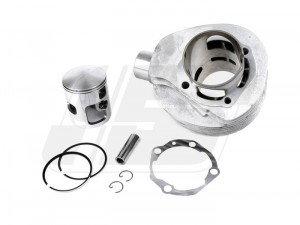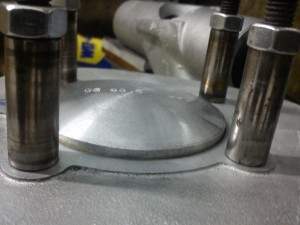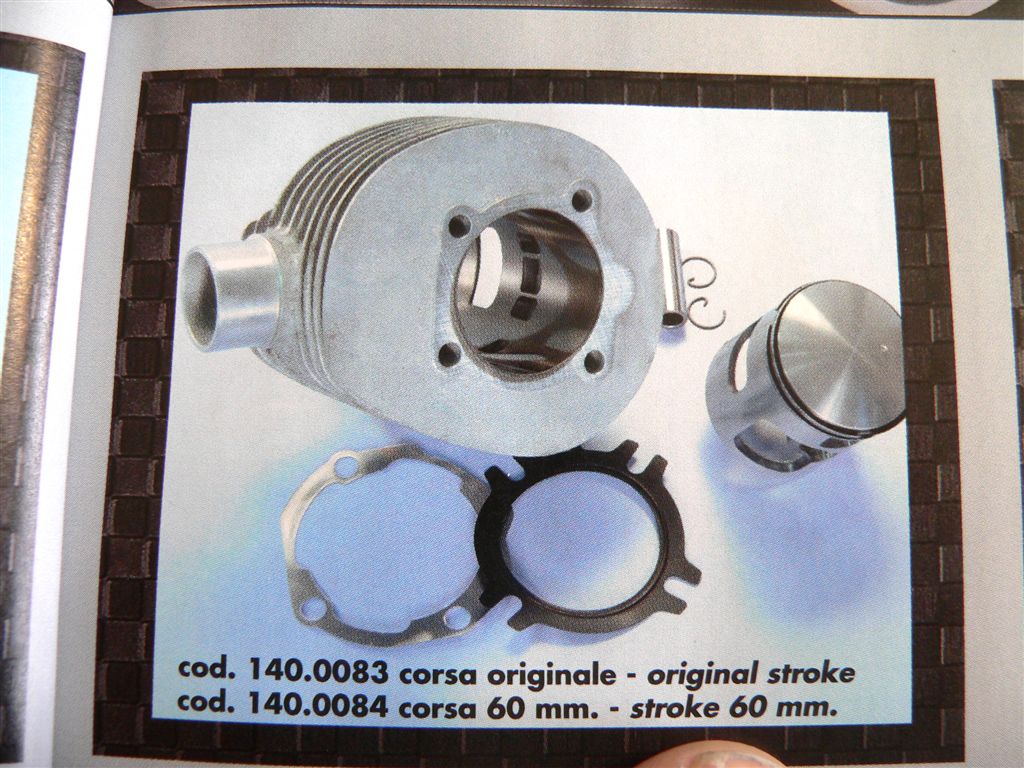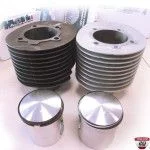 As already announced, Polini brings the 210cc cylinder in a version for use with a crankshaft with 60mm stroke (standard 57mm). The already available cylinder for 57mm stroke can only be driven to a limited extent with a crankshaft with 60mm stroke because the piston has an upper so-called L-ring.
As already announced, Polini brings the 210cc cylinder in a version for use with a crankshaft with 60mm stroke (standard 57mm). The already available cylinder for 57mm stroke can only be driven to a limited extent with a crankshaft with 60mm stroke because the piston has an upper so-called L-ring.
This type of ring includes or forms the upper piston closure, so it controls the channels and not the piston upper edge as usual. If you now use a crankshaft with a 60mm stroke, the 3mm extra stroke must of course go somewhere ...
Since the piston moves 1,5mm more up and 1,5mm more down, the cylinder must theoretically be lengthened by this 1,5mm. For practical reasons, for the sake of simplicity, a suitably strong base or head gasket is simply used.
The problem with the two-stroke engine is that it also has an enormous influence on the exhaust and overcurrent control angles, which are important for the performance characteristics. To make matters worse, in the stupidest case you do not change both to the same extent, but usually take advantage of the overcurrent angle. Both values (outlet and overflow angle) should always be in a ratio for the best possible power output.
In the case of the Polini, it looks like you are forced to use a foot seal. If you were to use a head gasket, the L-ring placed very high on the edge of the piston would simply rebound out of the raceway.
If a foot seal is used, the control angle is generally raised and, as already mentioned, the values are taken advantage of in favor of the overcurrent angle.
This can lead to the engine starting too late with its power output and also being stalled in the upper speed range by a pre-exhaust angle that is too small (the angle that the piston releases the exhaust in front of the overflow ducts). This means that it can turn down further, but the power curve drops very quickly after the power peak.
In order to preserve the characteristics of the Polini, it would be better to recommend the use of a head gasket to compensate for the multiple stroke. As mentioned above, this is not possible with the standard Polini piston, otherwise the piston ring would rebound.
Facts ...
If the Polini 210 comes with 57mm crankshaft used, it has a very touring-friendly 123 ° overflow angle and 171 ° outlet angle.
When using a crankshaft with a 60mm stroke and a 1,5mm thick base seal this changes to approx. 135 ° / 179 °.
In other words, the overcurrent angle increased by a full 12 ° CA, the outlet angle, however, only by 8 °.
Both the absolute increase in both values and, in particular, that of the overcurrent angle lead to a later increase in power. The whole thing can be done very well by using a tame, broadband touring exhaust system like one SitePlus, SIP Road be compensated.
The exhaust then still ensures good performance in the lower engine speed range, the greatly extended control angles allow the cylinder to rev up further in the upper engine speed range.
230cc ???
One of our customers (Thomas aka schoeni230) has exhausted the whole thing even further and a Polini 210cc aluminum cylinder with a special one 62,5mm long stroke crankshaft combined by Scooter & Service.
In order to avoid the problem of piston ring rebound mentioned above, the Polini was created here Piston against a counterpart of Grand Sport exchanged. This piston has only one piston ring and this is conventionally shaped and sits much deeper than the original L-ring in the Polini piston.
This made it possible to let the piston run out of the cylinder by the measure,
as the piston ring just gave:


As a result, the cylinder did not have to be lined very strongly at the cylinder base (approx. 0,4 mm) so that the control angle did not get too much out of balance despite a multiple stroke of a full 5,5 mm.
So the cylinder ran at ~ 133 ° / 179 ° and a special cylinder head that accommodates the piston in the head.
Due to the multiple stroke, the piston clearly undercuts the overflow channels at bottom dead center:
In connection with a modified Sito Plus exhaust (similar to the PEP3 exhaust), the engine impresses with its enormous torque in the lower rev range, an insane range and, measured by the exhaust type used, a very good top performance.
The carburetor was a 35mm Keihin PWK on a scooter & service Diaphragm intake manifold (myth V-Force membrane) used. One came as an ignition Vespatronic for use.

The cylinder has hardly been redesigned, only the outlet has been changed minimally in width and height.
And finally ...
Despite the very long steering angle, it is an enormously mobile and broadband motor that is sure to be the best for a touring rider. Full torque from the lower speed range and still still 20PS at well over 9000rpm.
Certainly not something that can be recreated, furthermore it is often problematic to let the piston extend that far out of the cylinder. Not only because of the then mandatory head centering to ensure that the piston does not hit the head, but also because of the increased thermal load on the zone above the piston ring.
The new Polini 210 for 60mm stroke will make the whole thing feasible for 'normal' screwdrivers, especially with a much cheaper 60mm stroke shaft. With it, many will certainly be able to build their 'dream' touring engine which combines a full torque with a wide speed range and a very good peak performance!
For those who find it takes too long for the 60mm Polini with 221cc to hit the market, this article encourages you to try out unusual combinations. Ie a Polini 210 for 57mm stroke with a 1,5mm base seal and 60mm crankshaft can also be expanded into a very nice touring concept.
In the sense of a well-known one (Harry B. from E.): try it, it works!















